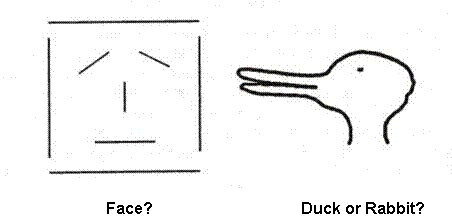

|
Scientific Understanding of Consciousness |
Neuronal Gestalts for the Dynamic Core of ConsciousnessGestalt psychologists found that the brain has the capacity to take degenerate stimuli and organize them into coherent wholes. (Searle; Mind: A Brief Introduction, 100) Basic unit of the selective process is not the individual neurons but the neuronal group. There are perhaps 100 million neuronal groups in the brain, and they range in size from 50 to 10,000 neurons. Neurons are only effective in groups, working toward a single goal, such as discriminating color or producing emotion. By virtue of their size, neuronal groups can compensate for individual cell deaths. (Ratey; User's Guide to Brain, 142) Consciousness arises as a result of traffic to and from many brain regions, some of them within the central part of the brain, well below the cortex and far below the area that is cut apart in split brain patients. (Greenfield; Centers of Mind, 67) Gestalt phenomena discovered by Max Wertheimer, Wolfgang Köhler, and Kurt Koffka (circa 1912) demonstrate how context-dependent perception is. (Edelman; Bright Air, 39) Gestalt psychologists suggested that the brain unconsciously applies a number of principles when we pick out a figure from the background. In gestalt psychology, the brain tends to group items which are close, similar to one another, which create a closed space, or achieve a smooth continuity of line. Modern work by researchers at Bell laboratories have examined precisely which features guide the visual system allowing objects to "pop-out" of an array in the background. (Zeman; Consciousness, 175) Visual search studies pioneered at Bell laboratories focused on the question: does the time taken to find a target increase as the number of distracting objects increases. For some combinations of target and distractors in visual search studies, the search is effortless; the target "pops out" of the display. Visual search pop-out depends not only on the local stimulus configuration, but also on more global textual or figural effects emphasized by Gestalt psychologists. (Koch; Quest for Consciousness, 158) Some visual patterns are too ambiguous for the brain’s gestalts to recognize one unique interpretation. Look at the bistable duck/rabbit drawing. Perception can flip from one interpretation to another, but consciousness is unitary, so you can only have one interpretation in mind at a time.
The famous "duck-rabbit" example, can be perceived as either a duck or a rabbit. (Searle; Mind: A Brief Introduction, 100)
Return to — Gestalts and ConsciousnessReturn to — Perceptual Categorization |
